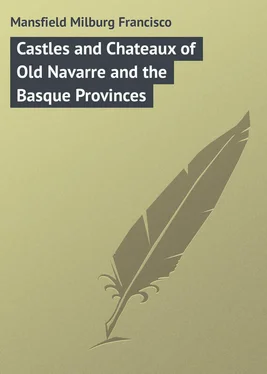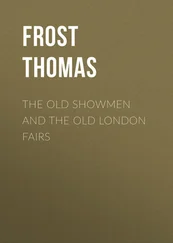Milburg Mansfield - Castles and Chateaux of Old Navarre and the Basque Provinces
Здесь есть возможность читать онлайн «Milburg Mansfield - Castles and Chateaux of Old Navarre and the Basque Provinces» — ознакомительный отрывок электронной книги совершенно бесплатно, а после прочтения отрывка купить полную версию. В некоторых случаях можно слушать аудио, скачать через торрент в формате fb2 и присутствует краткое содержание. ISBN: , Жанр: foreign_prose, на английском языке. Описание произведения, (предисловие) а так же отзывы посетителей доступны на портале библиотеки ЛибКат.
- Название:Castles and Chateaux of Old Navarre and the Basque Provinces
- Автор:
- Жанр:
- Год:неизвестен
- ISBN:http://www.gutenberg.org/ebooks/43609
- Рейтинг книги:4 / 5. Голосов: 1
-
Избранное:Добавить в избранное
- Отзывы:
-
Ваша оценка:
- 80
- 1
- 2
- 3
- 4
- 5
Castles and Chateaux of Old Navarre and the Basque Provinces: краткое содержание, описание и аннотация
Предлагаем к чтению аннотацию, описание, краткое содержание или предисловие (зависит от того, что написал сам автор книги «Castles and Chateaux of Old Navarre and the Basque Provinces»). Если вы не нашли необходимую информацию о книге — напишите в комментариях, мы постараемся отыскать её.
Castles and Chateaux of Old Navarre and the Basque Provinces — читать онлайн ознакомительный отрывок
Ниже представлен текст книги, разбитый по страницам. Система сохранения места последней прочитанной страницы, позволяет с удобством читать онлайн бесплатно книгу «Castles and Chateaux of Old Navarre and the Basque Provinces», без необходимости каждый раз заново искать на чём Вы остановились. Поставьте закладку, и сможете в любой момент перейти на страницу, на которой закончили чтение.
Интервал:
Закладка:
He loves immensely well to dance, too, the Roussillonnais, and he often carries it to excess. It is his national amusement, as is that of the Italian the singing of serenades beneath your window. On all great gala occasions throughout Roussillon a place is set apart for dancing, usually on the bare or paved ground in the open air, not only in the country villages but in the towns and cities as well.
The dances are most original. Ordinarily the men will dance by themselves, a species of muscular activity which they call “ lo batl .” A contrepas finally brings in a mixture of women, the whole forming a mélange of all the gyrations of a dervish, the swirls of the Spanish dancing girl and the quicksteps of a Virginia reel.
The music of these dances is equally bizarre. A flute called lo flaviol , a tamborin , a hautboy , prima and tenor , and a cornemeuse , or borrassa , usually compose the orchestra, and the music is more agreeable than might be supposed.
In Roussillon the religious fêtes and ceremonies are conducted in much the flowery, ostentatious manner that they are in Spain, and not at all after the manner of the simple, devout fêtes and pardons of Bretagne. The Fête de Jeudi-Saint, and the Fête-Dieu in Roussillon are gorgeous indeed; sanctuaries become as theatres and tapers and incense and gay vestments and chants make the pageants as much pagan as they are Christian.
The coiffure of the women of Roussillon is a handkerchief hanging as a veil on the back of the head, and fastened by the ends beneath the chin, with a knot of black ribbon at each temple.
Their waist line is tightly drawn, and their bodice is usually laced down the front like those of the German or Tyrolean peasant maid. A short skirt, in ample and multifarious pleats, and coloured stockings finish off a costume as unlike anything else seen in France as it is like those of Catalonia in Spain.
The great Spanish cloak, or capuchon , is also an indispensable article of dress for the men as well as for the women.
The men wear a tall, red, liberty-cap sort of a bonnet, its top-knot hanging down to the shoulder – always to the left. A short vest and wide bodied pantaloons, joined together with yards of red sash, wound many times tightly around the waist, complete the men’s costume, all except their shoes, which are of a special variety known as spardilles , or espadrilles , another Spanish affectation.
The speech of Roussillon used to be Catalan, and now of course it is French; but in the country the older generations are apt to know much Catalan-Spanish and little French.
Just what variety of speech the Catalan tongue was has ever been a discussion with the word makers. It was not Spanish exactly as known to-day, and has been called roman vulgaire , rustique , and provincial , and many of its words and phrases are supposed to have come down from the barbarians or the Arabs.
In 1371 the Catalan tongue already had a poetic art, a dictionary of rhymes, and a grammar, and many inscriptions on ancient monuments in these parts (eighth, ninth and tenth centuries) were in that tongue. In the twelfth and thirteenth centuries the Catalan tongue possessed a written civil and maritime law, thus showing it was no bastard.
A fatality pursued everything Catalan however; its speech became Spanish, and its nationality was swallowed up in that of Castille. At any rate, as the saying goes in Roussillon, – and no one will dispute it, – “one must be a Catalan to understand Catalan.”
The Pays-de-Fenouillet, of which St. Paul was the former capital, lies in the valley of the Agly. Saint-Paul-de-Fenouillet is the present commercial capital of the region, if the title of commercial capital can be appropriately bestowed upon a small town of two thousand inhabitants. The old province, however, was swallowed up by Roussillon, which in turn has become the Département of the Pyrénées-Orientales.
The feudality of these parts centred around the Château de Fenouillet, now a miserable ruin on the road to Carcassonne, a few kilometres distant. There are some ruined, but still traceable, city walls at Saint-Paul-de-Fenouillet, but nothing else to suggest its one-time importance, save its fourteenth-century church, and the great tower of its ancient chapter-house.
Nearer Perpignan is Latour-de-France, the frontier town before Richelieu was able to annex Roussillon to his master’s crown.
Latour-de-France also has the débris of a château to suggest its former greatness, but its small population of perhaps twelve hundred persons think only of the culture of the vine and the olive and have little fancy for historical monuments.
Here, and at Estagel, on the Perpignan road, the Catalan tongue is still to be heard in all its silvery picturesqueness.
Estagel is what the French call “ une jolie petite ville ;” it has that wonderful background of the Pyrenees, a frame of olive-orchards and vineyards, two thousand inhabitants, the Hotel Gary, a most excellent, though unpretentious, little hotel, and the birthplace of François Arago as its chief sight. Besides this, it has a fine old city gate and a great clock-tower which is a reminder of the Belfry of Bruges. The wines of the neighbourhood, the macabeu and the malvoisie are famous.
North of Estagel, manners and customs and the patois change. Everything becomes Languedocian. In France the creation of the modern departments, replacing the ancient provinces, has not levelled or changed ethnological distinctions in the least.
The low-lying, but rude, crests of the Corbières cut out the view northward from the valley of the Agly. The whole region roundabout is strewn with memories of feudal times, a château here, a tower there, but nothing of great note. The Château de Queribus, or all that is left of it, a great octagonal thirteenth-century donjon, still guards the route toward Limoux and Carcassonne, at a height of nearly seven hundred metres. In the old days this route formed a way in and out of Roussillon, but now it has grown into disuse.
Cucugnan is only found on the maps of the Etat-Major, in the Post-Office Guide, and in Daudet’s “Lettres de Mon Moulin.” We ourselves merely recognized it as a familiar name. The “Curé de Cucugnan” was one of Daudet’s heroes, and belonged to these parts. The Provençal literary folks have claimed him to be of Avignon; though it is hard to see why when Daudet specifically wrote C-u-c-u-g-n-a-n. Nevertheless, even if they did object to Daudet’s slander of Tarascon, the Provençaux are willing enough to appropriate all he did as belonging to them.
The Catalan water, or wine, bottle, called the porro , is everywhere in evidence in Roussillon. Perhaps it is a Mediterranean specialty, for the Sicilians and the Maltese use the same thing. It’s a curious affair, something like an alchemist’s alembic, and you drink from its nozzle, holding it above the level of your mouth and letting the wine trickle down your throat in as ample a stream as pleases your fancy.
Those who have become accustomed to it, will drink their wine no other way, claiming it is never so sweet as when drunk from the porro .
“Du miel délayé dans un rayon de soleil.”
....
“Boire la vie et la santé quand on le boit c’est le vin idéal.”
Apparently every Catalan peasant’s household has one of these curious glass bottles with its long tapering spout, and when a Catalan drinks from it, pouring a stream of wine directly into his mouth, he makes a “study” and a “picture” at the same time.
A variation of the same thing is the gourd or leathern bottle of the mountaineer. It is difficult to carry a glass bottle such as the porro around on donkey back, and so the thing is made of leather. The neck of this is of wood, and a stopper pierced with a fine hole screws into it.
Читать дальшеИнтервал:
Закладка:
Похожие книги на «Castles and Chateaux of Old Navarre and the Basque Provinces»
Представляем Вашему вниманию похожие книги на «Castles and Chateaux of Old Navarre and the Basque Provinces» списком для выбора. Мы отобрали схожую по названию и смыслу литературу в надежде предоставить читателям больше вариантов отыскать новые, интересные, ещё непрочитанные произведения.
Обсуждение, отзывы о книге «Castles and Chateaux of Old Navarre and the Basque Provinces» и просто собственные мнения читателей. Оставьте ваши комментарии, напишите, что Вы думаете о произведении, его смысле или главных героях. Укажите что конкретно понравилось, а что нет, и почему Вы так считаете.












